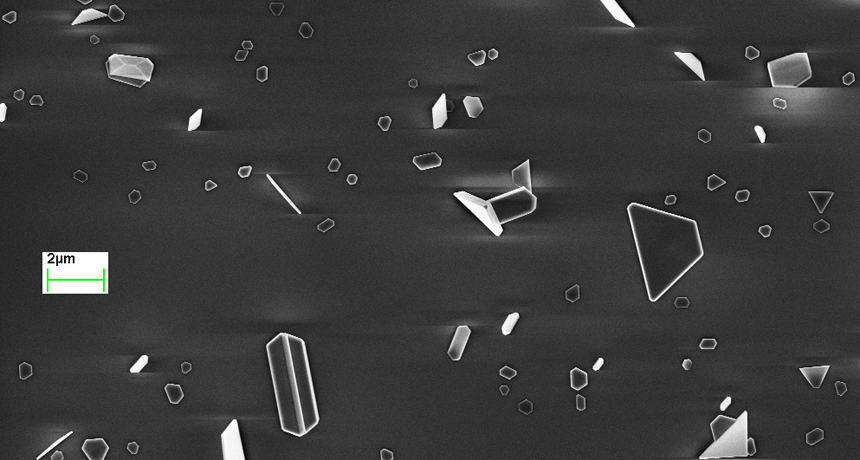Light dancing on glass
New type of material lets light travel across its surface without interruption

This image, taken with a powerful microscope, shows tiny, individual crystals of bismuth telluride. A new structure made from this material lets light travel easily and without interruption along its surface.
A13ean/Wikipedia
Light can’t always get from one place to another with ease. It may be absorbed, as by dark objects. It may be reflected, as by a mirror. And it may be scattered, or reflected in all directions. Now, scientists have shown that a new type of structure allows light to travel along its surface with ease. No scattering. No reflecting. And no interruptions.
Scattering can be a problem when light has to do a job, such as carry information in fiber-optic cables. Such cables, typically used in high-speed telecommunications, work best when they keep light scattering to a minimum. To do that, scientists built a new structure from a special type of crystal. Solid crystals usually have imperfections that hinder light, just like bumps on a road. Not the new crystals.
And using the new crystals, “light goes right around any obstacles, which is pretty remarkable,” says Michal Lipson. “I think it’s wonderful,” she told Science News. Lipson is a physicist at Cornell University and was not involved with the study.
The new material is an example of a “topological insulator.” Topology is the study of surfaces. And an insulator stops something, such as light or electricity, from passing through. A topological insulator combines these two ideas in a strange and exciting way. The inside of the material acts as an insulator. But its surface behaves differently.
In 2005, physicists first suggested that topological insulators could exist. Soon after, scientists raced to prove it. The first topological insulator appeared in 2007. It blocked the flow of electrons inside it but allowed those particles to flow freely across its surface. (Electrons are negatively charged particles that carry electricity. A stream of electrons is called an electric current.)
Scientists wondered if topological insulators would work for light, too. Physicist Mordechai Segev of the Technion-Israel Institute of Technology in Haifa led the new work. Segev and his coworkers created their material by etching hundreds of spiral-shaped paths through a block of glass. Those paths acted like wires. But here, they guide light, not electricity.
The etched spirals stopped light from traveling through the material. They did, however, let light travel along its surface with ease. Segev’s team reported its new achievement in the April 10 issue of Nature.
The new material could lead to faster and more efficient ways of using light to send data from one place to another, says Jacob Taylor. He’s a physicist at the University of Maryland in College Park.
Segev told Science News he’s proud to have led the first team to create a topological insulator for light. “There were a number of groups competing to try to achieve this,” he says. “We’re happy to have won the race.”
Power Words
physics The scientific study of the nature and properties of energy and matter.
topology The mathematical study of surfaces.
insulator A substance or device that does not readily conduct electricity.
electron A negatively charged particle; the carrier of electricity within solids.
fiber optics The use of thin, flexible fibers of glass or other transparent solids to transmit light signals, primarily for telecommunications.







